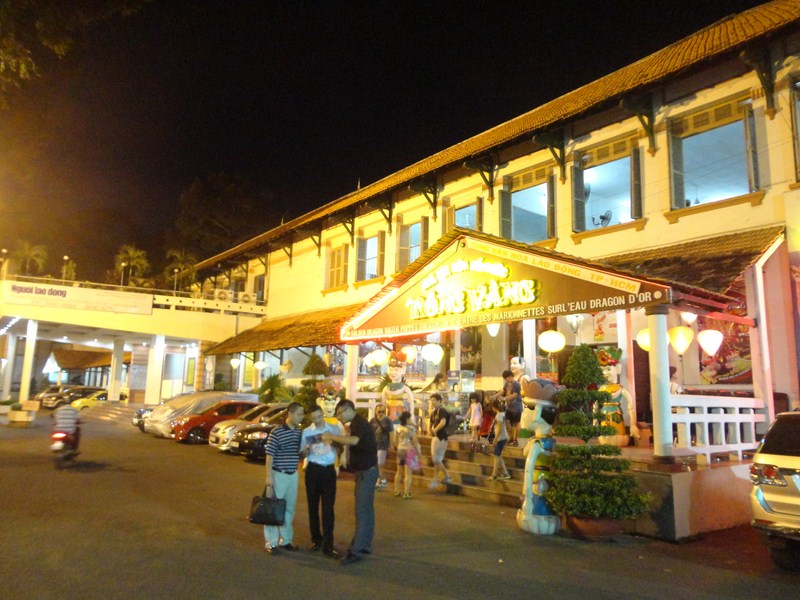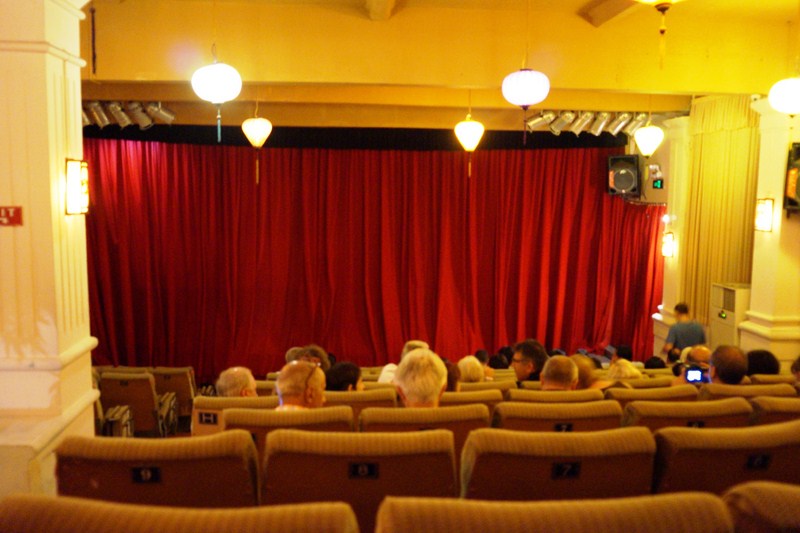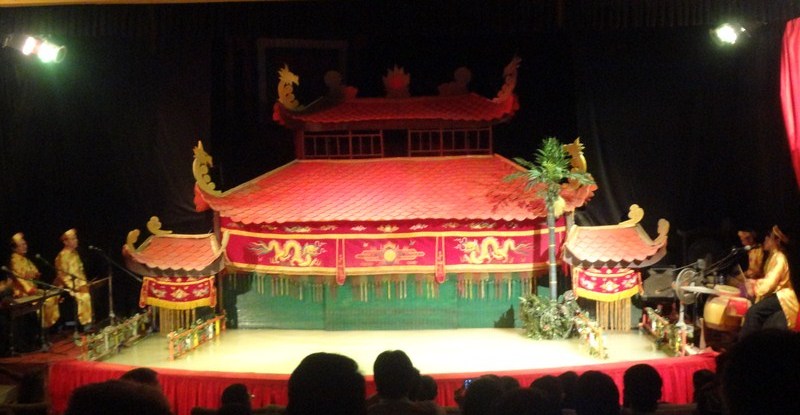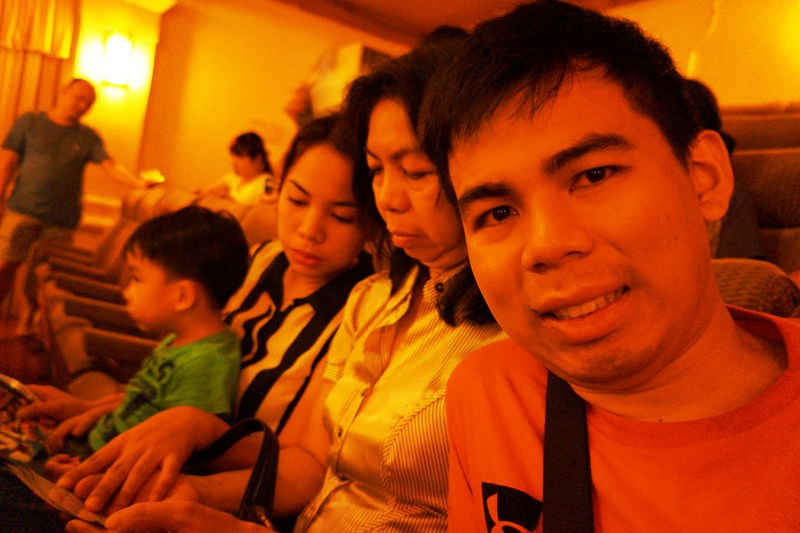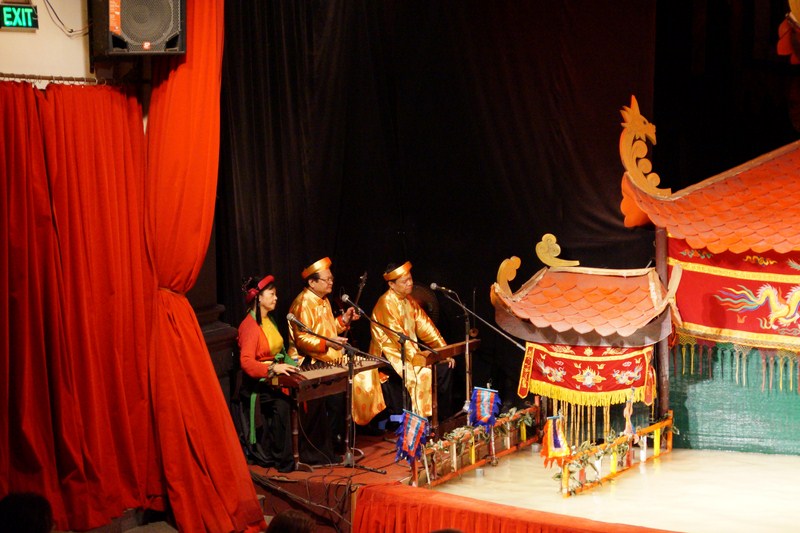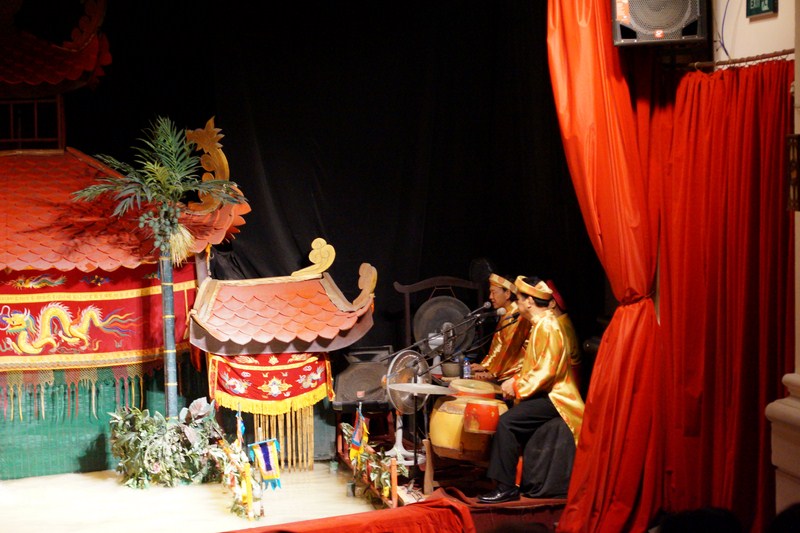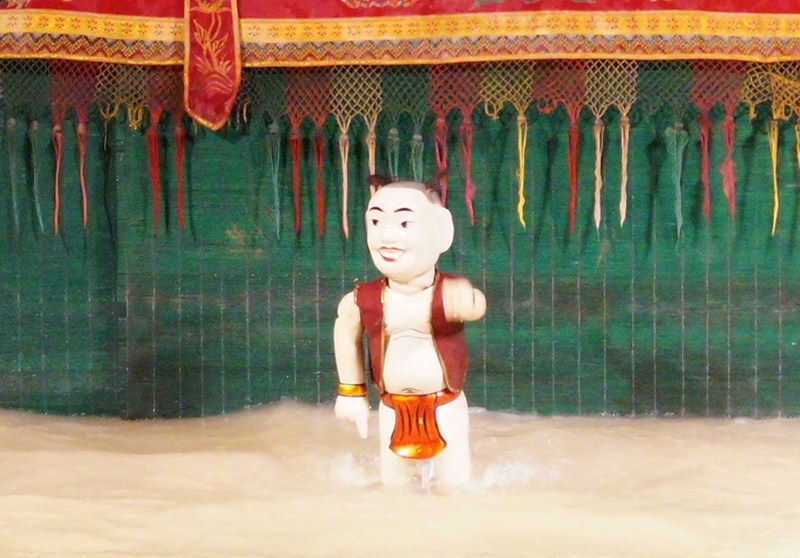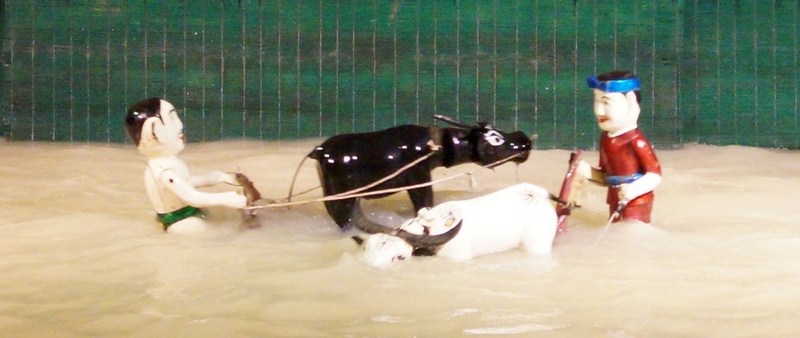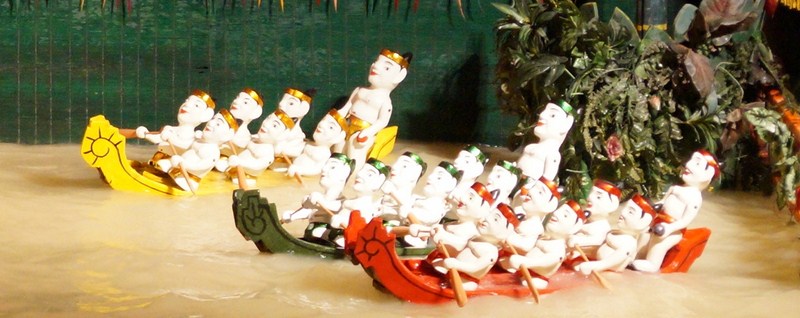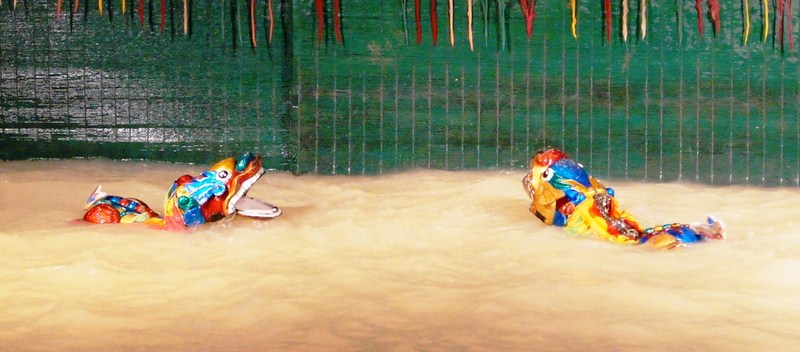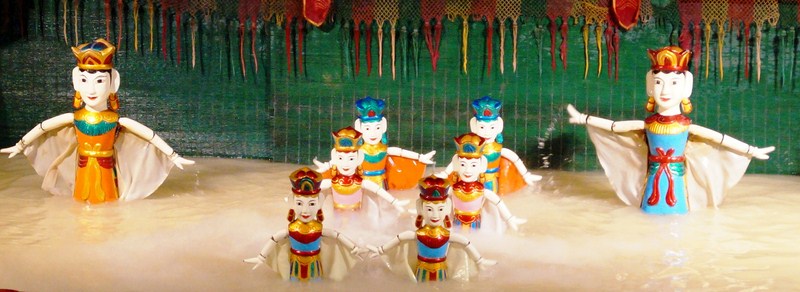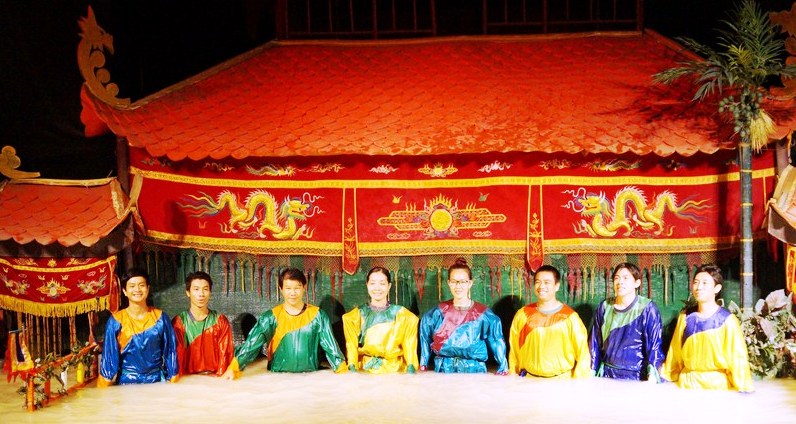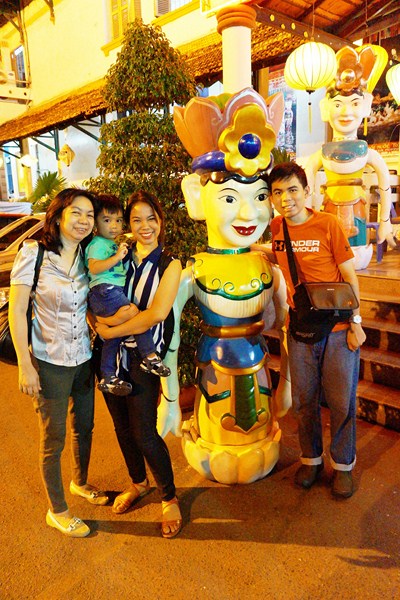Upon our arrival at the Elios Hotel in the Pham Ngu Lao area, I checked out pamphlets and advertisements for various tourist activities in the city. Among the pamphlets is one for the Golden Dragon Water Puppet Theater, the pre-eminent water puppet theater in Ho Chi Minh City, which outlandishly claims that you “haven’t really been to Vietnam until you’ve seen a water puppet show.” This 50-minute long show features marionette puppets in water.
The exact time when water puppetry (múa rối nước), began in Vietnam is not known. However, the oldest record mentioning water puppetry is found on an inscription on a stone stele called Sùng Thiện Diên Linh, dating from 1121, which was found in Đọi Sơn Pagoda, Duy Tiên District, Hà Nam Province, about 50 kms. from Hanoi. It eulogized the merits of King Ly Nhan Tong and describes a scene: “A golden tortoise, with three mountains on its shell, was seen on the rippling surface of the water. It showed both its carapace and four legs… the cavern’s entrance opened and fairies in the play appeared…Flocks of precious birds and herds of animals sang and danced…”
From the 11th to 14th centuries, after a period of rapid development, the art of water puppetry escaped the confines of the royal palaces of the Le and Nguyen dynasties and began showing up at village festivals and ceremonies in the Red River Delta, thus jump-starting the development of the country’s traditional stage arts. This art form, unique to Northern Vietnam, was first displayed in Hanoi in 1958 and, in 1973, the first state-run puppetry troop was established to serve the public audience. In 1984, as a result of normalized relations with the West, Vietnamese water puppetry was introduced to the world stage for the first time (in France).
During the early 1990s, the country’s three foremost companies, the National Puppet Theatre (Nhà hát Múa rối Trung Ương), the municipal Thăng Long Puppet Company (Nhà hát Múa rối Thăng Long) of Hanoi and the Hồ Chí Minh City Puppet Company (Đoàn Nghệ thuật Múa rối Thành Phố Hố Chí Minh) gained increased international attention. Today, the main venues in Vietnam are the Thăng Long Water Puppet Theatre in Hanoi and the Golden Dragon Water Puppet Theater in Saigon.
After a short rest at our hotel and lunch at a nearby noodle house, Grace and I checked out a nearby travel agency where we booked ourselves for the last 7:45 PM show (other show times are 5 PM and 6:30 PM). The regular admission per person at the ticket booth is US$7.50 and since the theater hosts three shows a day, obtaining tickets is not difficult. However, to facilitate things we paid the travel agent US$9.00 per person which included our taxi fare going there.
We arrived at the theater, which is just a short distance from the Reunification Palace in the Labour Cultural House, half an hour before the start of the show. The red velvet-covered auditorium seats around 200 visitors but, though we weren’t in the first few rows (which is definitely a splash zone), we were seated at the back rows which was quite far from the stage. Luckily, the theater wasn’t fully booked that night and, minutes before the start of the show, we were allowed to transfer to the middle row.
The show, with no intermission, was performed entirely in Vietnamese. It is about the ancient origins of Vietnam and its rural upbringings, with a splash of the mythical goddesses, dragons and talking fish that go along with the traditional stories.
The orchestra of this modern theater consisted of professional musicians and singers, sitting in their traditional au dais, are set off to the left and right sides of the stage. They play traditional musical instruments like drums, clarinets, cymbals, Chinese guitars, bamboo flutes, zithers, two-stringed violins and, the most noteworthy instrument of them all, a monochord with a single string which can create wonderful tune. The singers not only accompany the orchestra but also converse with puppets, especially with the humorous and intelligent puppet Uncle Tễu which functions as the master of ceremonies. The show is split into around 12 acts, each telling a separate story.
As in other traditional Vietnamese performing arts such as chèo (popular opera), tuồng (classical opera) and cải lương (renovated opera), the program started with a boisterous music composition to attract attention and create a joyful atmosphere. The colorful puppets danced and performed numerous interesting items on the shimmering water surface of the water stage in the theater, accompanied by animated music and singing. They even performed acrobatics, spectacular acts which cannot be done by modern robots. We saw no puppeteer, no machines, instruments or controlling strings and poles. By grandson Kyle was spellbound by the performance.
A lot of the scenes were easy to understand, even for non-Vietnamese speakers like me, but there were scenes that were quite hard to follow. Sometimes, an entire act finished and I only had only a slight idea of what happened. I can understand why some people would dislike the show. However, this traditional but highly developed Vietnamese art form, handed down for nearly 1,000 years, is full of joy, lighting and colors, myriad charms and shocking surprises and is enjoyable to watch. Watching it, we immediately experienced the boisterous and joyful atmosphere of a real folk festival. The jubilant and sweet puppets particularly enchanted us with their hilarious games. This is the power which can only be found in a water puppet.
Though we can watch the water puppet show on VCDs, DVDs, television programs or on YouTube, none of these can replace the real live performance in which we sat near a sparkling water surface. The handling of the water puppets was ingenious and the puppet’s voice actors are truly skilled and multi-talented. Both contributed to a fascinating performance. Most shows do get pretty full so, to get the best seats in the house, show up early. To be less confused, read the pamphlet which is distributed outside the theater. It briefly explains what each scene is about.
Golden Dragon Water Puppet Theater: 55B Nguyen Thi Minh Khai St., Ben Thanh Ward, District 1, Ho Chi Minh City, Vietnam. Tel: +84 8 3930 2196(booking office) and (84) 0913874808. Email: nhahatrongvang@gmail.com. Website: www.goldendragontheatre.com. Daytime performances are by special arrangement.

